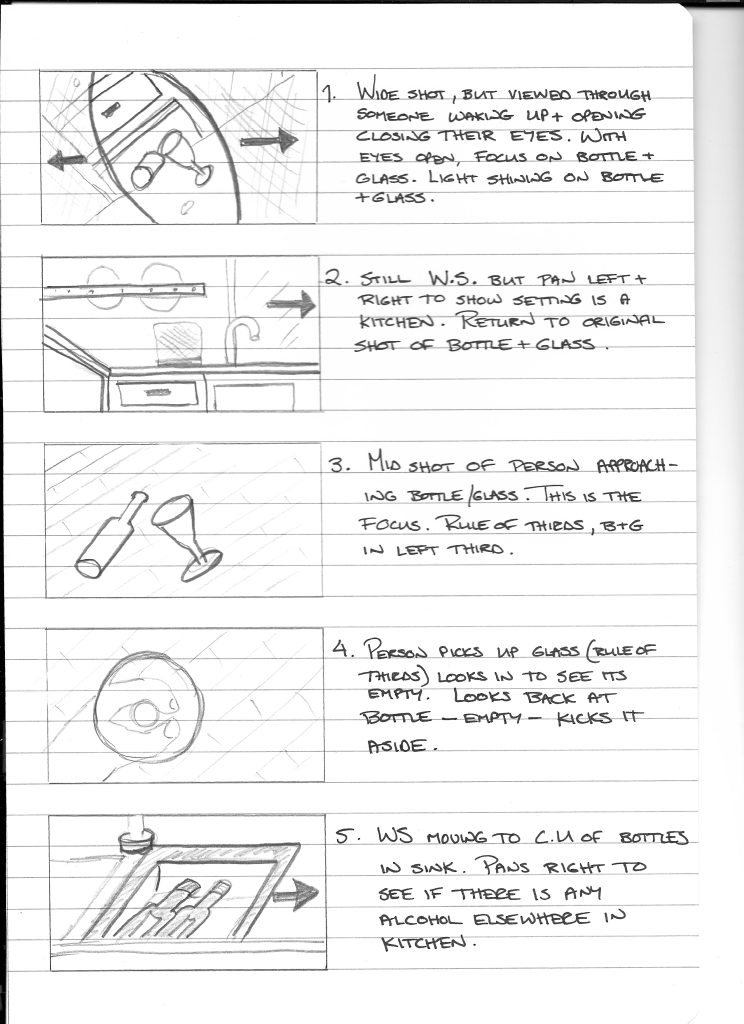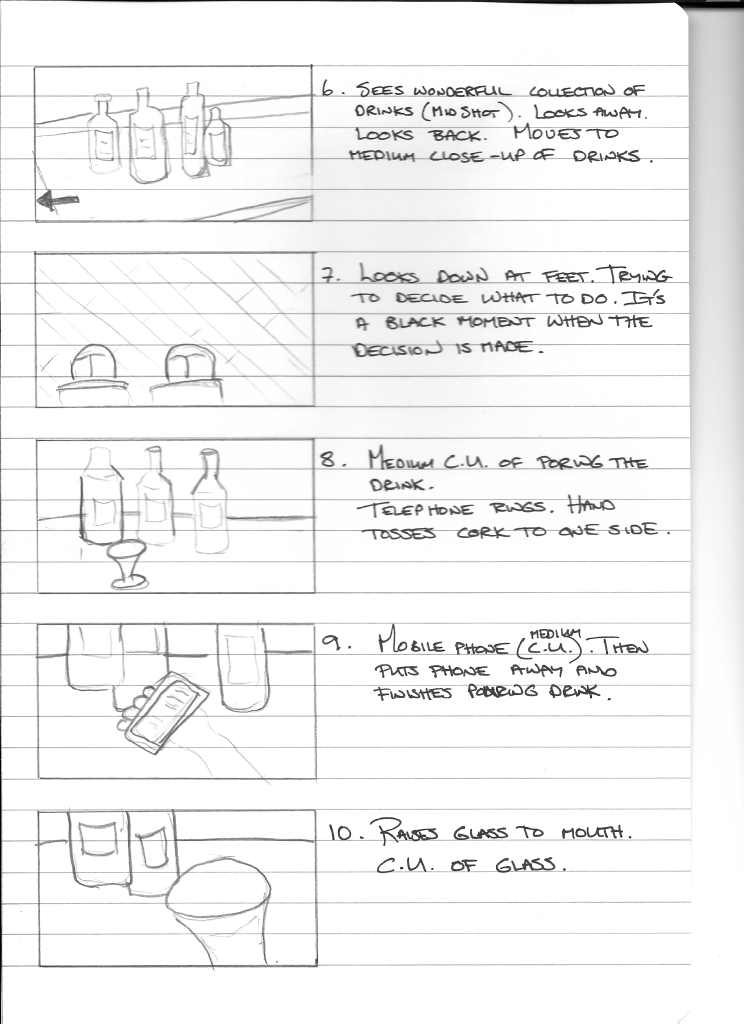For this exercise you are given a briefing for an alcoholic alone at home. You are to draw up the storyboard, noting the shot sizes and what should be in the frame. it’s an exercise in working out what should be in the frame to convey the story. You then record the shots and do an analysis.
Here is the sequence:
I was going to shoot this in out sitting room during the day and sketched the original storyboard with this setting. When I made the first few attempts to film it, I realised that I had a very big problem with contrast. We have a lot of windows/natural lighting in our house and so each time I moved the camera past a window, the scene got very badly burnt out. So, I changed the setting and made it at night with the shutters down and used some studio lighting to light just the one room – the kitchen. This worked well but I then had to factor in that there were studio lights and that they could not be in the shot – film the lighting not the lights!
Here is my storyboard with comments alongside about the type of shot and what the focus of the shot should be.


Reflection on the sequence
Shot 1: The framing of this shot conveys a lot of information relatively quickly; it goes straight to the main focus (bottle/glass on floor), indicates that it is a subjective POV shot and that the person is lying on the floor (canted angle of the shot). The blurring in and out as the person opens/closes their eyes is meant to show that the person could be hung over.
How could I improve this shot: I’m happy with the composition and framing of this shot. I used two pieces of cardboard to simulate eyes opening/closing and the sound of this was not natural (even for someone with a hang over!) and so I had to drop the sound for this part- this could be improved – I don’t know if it can be done in editing afterwards.
Shot 2: The shot is meant to give the viewer an idea of the environment (the kitchen) and reinforce that the person is lying on the floor looking up. By taking this shot from the floor the sense of confusion is enhanced. The wobbliness of the camera movement is meant to convey the instability of the person.
How could I improve this shot: I would have preferred to have a wider view of the kitchen and to capture the floor and the top of the counter. However it would not have looked right to zoom out since eyes don’t do that. I couldn’t cut to a zoomed out view because that would have also implied that the person had moved backwards for no apparent reason.
Shot 3: This is a very simple shot with primarily the bottle/glass in the shot. The focus is obvious. At the end of the shot you see the persons feet to provide some scale and also to let the viewer know that the subjective POV shot has been maintained. I tried to maintain the rule of thirds as I approached the bottle and glass which was harder to do that I had thought it would be.
How could I improve this shot: I’m happy with this shot.
Shot 4: The person reaches down to pick up the glass and looks inside – it is empty. This shot respects the rule of thirds with the glass in the left third of the frame. In addition, there are no distracting elements in the background – it’s a shot of the glass. Then the person looks down at the empty bottle and is clearly annoyed by it being in the way (and presumably also annoyed because it is empty) and kicks it aside. I put a light on the floor to light up the bottle and also the area where the bottle would be kicked towards.
How could I improve this shot: I’m happy with this shot.
Shot 5: The focus now shifts to the immediate environment and zooms in first on what is in the sink – more empty bottles, and then what is on the counter, or more correctly that there is no alcohol.
How could this shot be improved: This was one of the shots I was least happy with. Firstly there was a composition problem as I moved toward the sink – it would have been better if I had framed the water spout in the shot instead of cutting it off at the top – very annoying! I had dwelled too long on the counter before moving to the next shot and had to find a place to cut it that didn’t look too jumpy – I did the best I could but would have preferred to reshoot this. Since it was all in subjective POV, there didn’t seem to be a natural place to make a cut so I stayed with a continuous POV.
Shot 6: This is the shot where the person finds what they are looking for – the drinks. The person is happy to have found what they are looking for, but then hesitates and looks back to the original counter, but then can’t resist looking back at the drinks bottles.
How could I improve this shot: I had the same problem as the previous shot – the shoot was too long and I had to find a natural point to cut it without creating too much of a jump in the shot. The solution would be to reshoot and make sure that the cut is unnecessary in the first place.
Shot 7: This was my most difficult shot in terms of convey its meaning. I wanted the person to have to decide whether to avoid having another drink or to give in and have that next drink. I faded to black to convey that it was a dark moment and that the outcome was not going to be good. I’m not sure how successful this was.
How I could improve this shot: Although I’m not sure the shot conveys the meaning I intended, I don’t know how else I could have done it.
Shot 8: In this shot, the decision has been made to drink and now what remains is the choice of drink. To do this visually, I tried to make it a bit upbeat (something like – having made the decision to drink, the person is fully engaged and enjoying the prospect of having the next drink). Once the person starts pouring the drink, their mobile bleeps.
How I could improve this shot: I was happy that I was able to keep everything I wanted in this shot without cutting the edges off anything. I had to have help with shooting this shot as both my hands are occupied and someone else needed to hold the camera just above my right shoulder. The difficulty was keeping my shoulder out of the shot so that it became obvious that it was not through the persons eyes. The solution was to primarily use my left hand and keep my right hand/arm as static as possible.
Shot 9: The mobile phone is the focus of this shot. It’s an annoyance and quickly done away with so that the person can get back to the drink.
How I could improve this shot: I’m happy with this shot.
Shot 10: This is the quick finale – having that sip. The shot is of the glass moving towards my mouth.
How I could improve this shot: Since the camera was at my shoulder I had to move the glass to the camera not my mouth. I chose the best shot I could find of the various takes, but it still didn’t really look like the glass was heading for my mouth. To solve the problem, I faded to black as the glass is lifted. And anyway it was about nine in the morning, I wasn’t really going to start sipping away – especially since we did quite a few takes!!
Overall reflection: Filming only a subjective POV shot is quite limiting and you have to think creatively about how to make it interesting. I think one of the things that would quite naturally support a film that is made up of only subjective POV shots would be an internal narrative, since that is what would naturally support the context (i.e. we do not only see through our eyes silently, we have an internal narrative going on.) Without that narrative removes a vital part of the message.
It certainly made me think about how much more possibility you have when you are able to film from an objective POV or when you can switch between subjective and objective POV shots.
I was very indecisive about whether to retake some of the shots or not. In the end, I decided that I was able to learn from the analysis without having to redo the shot. If this is an exercise in learning, then it makes sense to note what has been learnt and try to apply it to the next project. I remember reading the introductory notes to this course where there was quite a bit of emphasis placed on not expecting each sequence to be your masterpiece but rather as a way to learn – now I understand why that was written, as I was in danger of getting stuck on this exercise. I decided to learn from the mistakes and move on.

I thought the film was well thought out. The starting position with the dutch angle worked well. Im not sure the cardboard eyelids were needed, a simple screen fade may have achieved the same results.
I liked the way you moved around the kitchen before eventually settling on the area that had the alcohol. The mood to me felt a little odd on finding the alcohol. I wouldnt have thought a drunk would be ‘happy’.
The storyboards were easy to follow and the explanations provided a good insight into your thought process,
Thanks Paul for the comments. You are right about the ‘happy’ drunk – I was wanting to show an alcoholic who hasn’t quite realized how serious their drinking problem is yet, so although they know they are drinking too much, once committed to having a drink, they are quite excited/positive about the prospect. I did wonder if this work or not. Thanks again for the comments.
Commenting here as well 🙂 I love this video, I’ve watched it several times and always think how clever it is. I especially love the cardboard eyelids, very creative and it was very effective as well. Love the beginning, the angles were great, I like the way you said oh yes…oh no… Great work. Looking forward to seeing your future videos 🙂
I agree with you about working hard on the exercise but then learning from any mistakes and pushing on with the course as opposed to spending time going over them.